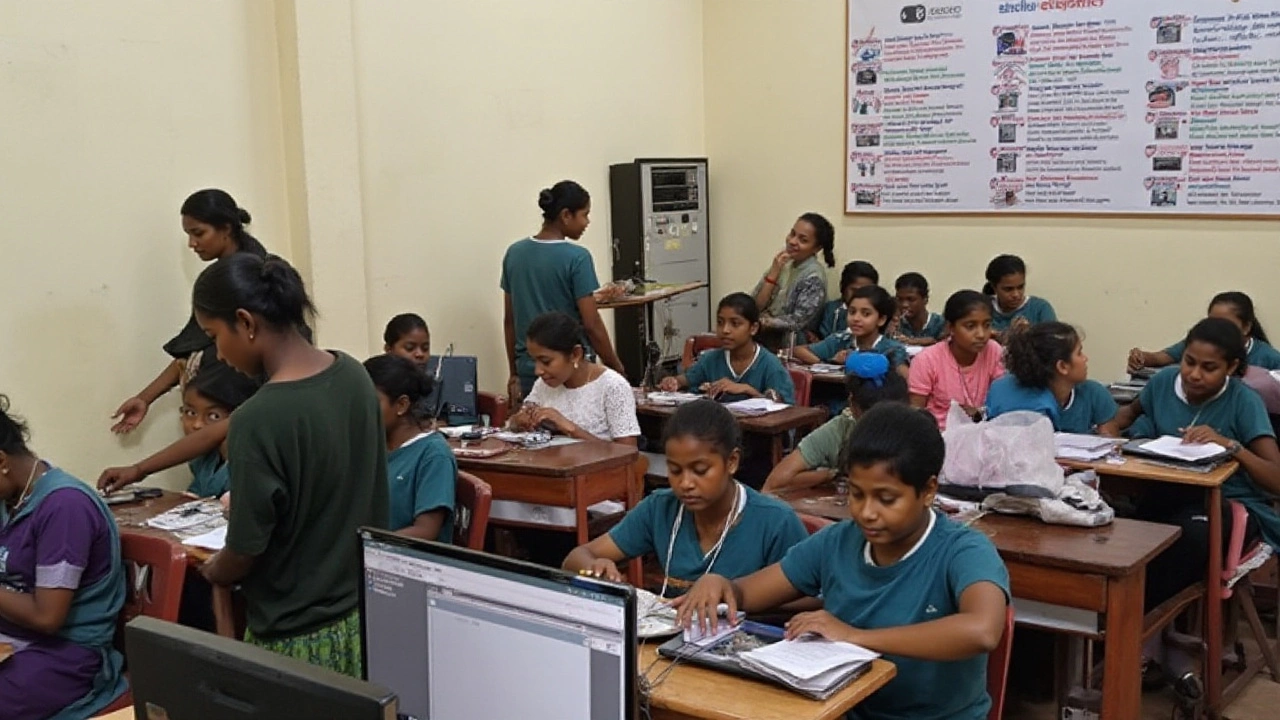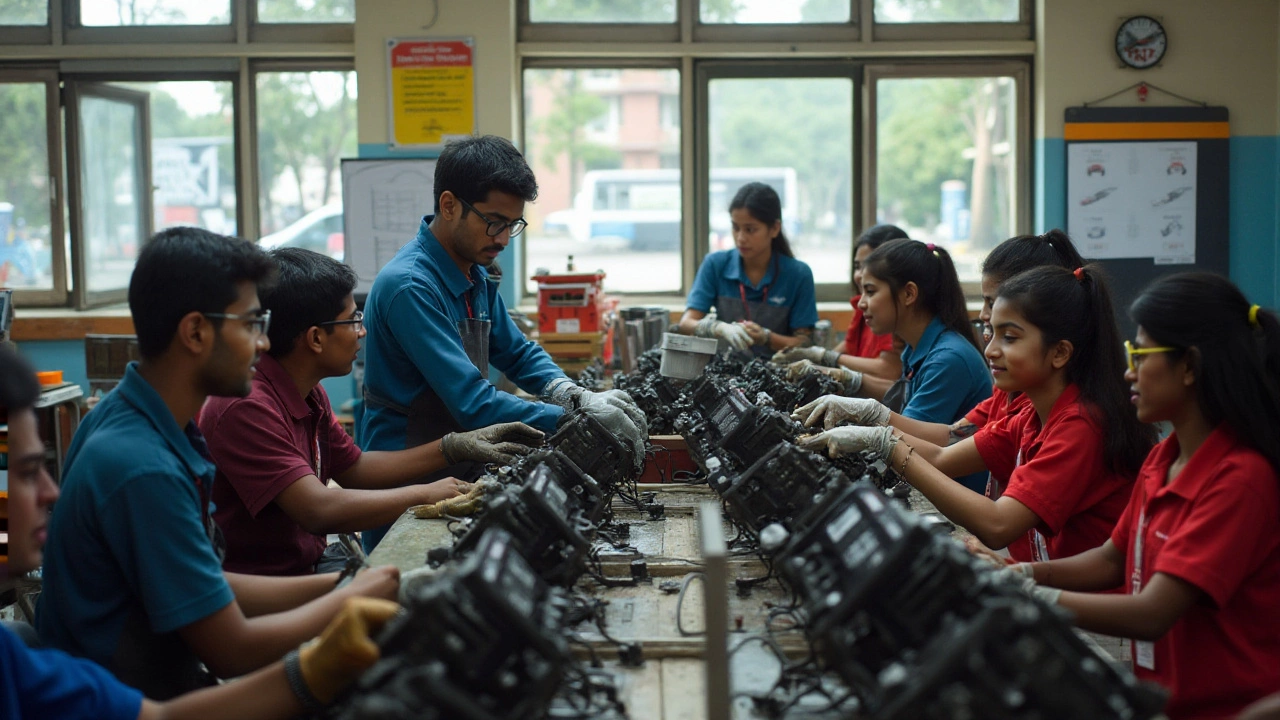
In today's fast-paced world, vocational training emerges as a powerful tool to bridge the gap between education and employment. While traditional academic paths focus on theory, vocational courses prioritize practical experience, providing learners with the skill sets needed for specific job roles.
Whether you aim to become a skilled carpenter, a proficient coder, or an adept healthcare assistant, vocational training offers tailored programs to suit your career ambitions. This form of education is notably hands-on, preparing students to enter the workforce with confidence and competency. Let's delve into what vocational training entails and how it can pave the way to a fruitful career.
- Defining Vocational Training
- Why Choose Vocational Training?
- Examples of Vocational Training Programs
- Benefits of Vocational Training
- How to Enroll in a Vocational Course
- Future Trends in Vocational Education
Defining Vocational Training
Vocational training is more than just an educational path; it is a gateway to acquiring specific skills and knowledge that align directly with various industries and job functions. Often described as technical education, this approach diverges from the typical academic journey by focusing intensively on practical skills. Unlike traditional studies that may emphasize a broad spectrum of theories and concepts, vocational courses are tailored to meet the demands of the job market, offering students the opportunity to become proficient in areas that require hands-on experience. This method of learning is especially vital in fields that demand immediate competence, such as automotive repair, culinary arts, and digital technology. As the workforce evolves, vocational training plays a crucial role in meeting employer needs by producing a skilled workforce equipped to tackle current and future industry challenges. Vocational training is a proactive solution to employment barriers, enabling learners to enter the workforce swiftly and efficiently.
The concept of vocational training has roots stretching back to the medieval guilds, where apprentices learned trades directly under the guidance of masters. Today, this form of education has evolved dramatically, emphasizing a structured curriculum that balances theoretical and practical instruction. Institutions that offer these courses often build strong ties with industry leaders to ensure their educational offerings remain relevant and valuable. A report from the National Center for Education Statistics noted that over 70% of students who engaged in vocational programs felt adequately prepared for their respective careers, highlighting the effectiveness of this educational approach. In a world where technology and innovation drive rapid change, remaining adaptable and equipped with the right skills is advantageous. Vocational training serves this adaptive need, continuously updating its framework to mirror the shifts in the professional landscape.
"Vocational training is the practical approach to lifelong learning, providing opportunities for individuals to excel in technology-driven workplaces." - Jane Smith, EduTech Innovator
One of the distinguishing features of vocational training is its focus on people's holistic development. It aims to hone not just technical skills but also soft skills such as communication, teamwork, and critical thinking. These courses are structured to develop well-rounded professionals by blending classroom instruction with real-world applications. For instance, a culinary arts program might involve working in a student-run restaurant, where learning does not end with cooking techniques but extends to customer service, menu planning, and inventory management. By integrating these experiences into the curriculum, vocational training ensures that students understand every facet of their chosen profession and are well-prepared to meet industry expectations.
When considering vocational courses, prospective students should evaluate various factors such as program accreditation, industry partnerships, and employment outcomes. For students keen to enter the market quickly, many programs offer intensive, short-term courses that enable individuals to gain expertise in a matter of weeks or months. Others may prefer comprehensive programs that provide a deeper dive into the field, often resulting in certifications or diplomas. Regardless of the path chosen, vocational training remains an indispensable part of the educational landscape, promising to mold resourceful individuals who are ready to seize opportunities in an ever-changing economic environment. Students worldwide find value in programs that blend technology with tradition, offering the perfect balance needed in today's workforce. With vocational training, they can shape their futures and the world in meaningful ways. This kind of education is the cornerstone of a workforce prepared to innovate, adapt, and excel.
Why Choose Vocational Training?
As the demand for skilled workers continues to grow, vocational training stands out as a highly attractive option for students and career changers alike. Unlike traditional academic routes that often focus on theoretical knowledge, vocational programs offer a more practical approach, gearing students up for specific roles in the workforce. With an emphasis on hands-on learning, these programs ensure that learners acquire the technical skills and expertise needed in their fields from day one of employment. This is particularly valuable in sectors like healthcare, technology, and skilled trades, where the need for competent, job-ready individuals is steadily on the rise. As a result, vocational training can significantly enhance your employability and career prospects.
One of the key advantages of vocational training is the shorter duration compared to conventional college degrees. Most vocational courses take about one to two years to complete, enabling students to quickly enter the job market and start earning a stable income. This is ideal for those who wish to gain a foothold in their chosen industry without incurring the heavy debt often associated with long-term formal education. When looked at from a financial perspective, opting for vocational training can thus be a prudent choice.
Moreover, many vocational training institutions maintain strong ties with industry partners, offering learners ample networking opportunities and pathways to internships or apprenticeships. These connections can play a crucial role in opening doors to employment right after graduation—a critical aspect in competitive job markets. In some cases, vocational schools even tailor their curricula based on industry demands, ensuring that students are equipped with precisely the skills that employers are seeking. As a result, graduates from vocational courses often find themselves with job offers soon after—or even before—completing their training.
In the words of industry expert Linda Brooks, "Vocational training bridges the gap between education and employment. It gives students a head start by fostering real-world skills needed for today’s technical jobs."
Some sectors, like electric and construction trades, see over 30% of positions filled by vocational graduates, highlighting the economic value of this educational route.This statistic underscores the role of vocational training in meeting the labor demands of vital industries, which benefits not just individuals, but the economy as a whole.
For individuals aiming to switch careers, vocational courses offer a convenient avenue to reskill or upskill. Rather than starting from scratch with a new degree, aspirants can leverage these programs to quickly gain expertise in their new field. This is especially beneficial for adults balancing education with existing job commitments or familial responsibilities. With flexible learning options such as online classes or evening courses, vocational training is designed to accommodate diverse learning needs and lifestyles.

Examples of Vocational Training Programs
Vocational training touches almost every industry, offering a pragmatic educational path tailored to job-specific skills. For those intrigued by healthcare, pursuing a career as a medical assistant is a popular choice. This program typically covers anatomy, physiology, and medical office procedures. It's designed as an intensive, precise course that prepares you effectively for assisting doctors and nurses in various clinical settings. In approximately one year, you're ready to step into the healthcare field as a competent professional.
Technology-focused individuals might find themselves drawn to programming bootcamps. These intensive courses equip learners with coding skills in just a few months. They're not just about learning a programming language; they dive deep into problem-solving and practical applications. The technology industry values hands-on experience, and these bootcamps provide just that. As the digital sphere expands, having proficient programmers is quintessential for businesses worldwide. A quote from the CEO of a leading tech company states,
"Vocational courses in coding are short but impactful, serving as the stepping stones to dynamic careers in the digital age."
If you're captivated by craftsmanship, trades such as carpentry or plumbing might speak to you. Carpentry apprenticeships focus on mastering techniques and building projects from scratch. They blend site experience with classroom learning, ensuring that trainees can turn design ideas into tangible structures. On the other hand, plumbing courses address essential skills like pipe fitting and system inspection, beneficial for those aspiring to work in construction or maintenance. Hands-on learning techniques allow students to grasp the intricacies of these trades, addressing both creativity and functionality.
For the culinary enthusiasts, chef training programs combine classroom instruction with kitchen experience. Culinary schools focus on teaching foundational cooking skills while allowing students to specialize, ensuring they're well-versed in everything from classic techniques to modern gastronomy. This type of vocational training bolsters an individual's expertise in the culinary arts, preparing them for work in upscale restaurants or catering businesses. In the words of a famed chef,
"True culinary prowess comes from both theory and the sizzle of a busy kitchen."
Moreover, the beauty industry offers both cosmetology and esthetician courses. These immersive programs teach techniques for hair styling, skincare, and makeup. Such training not only enhances one's creativity but also offers entrepreneurship opportunities. You can open your salon or beauty business with the skills acquired. This presents a unique blend of creativity and commerce, appealing particularly to those with a passion for beauty and trends.
In the world of skilled trades, electrical apprenticeships stand out as critical vocational programs. These offer thorough training in installing, maintaining, and repairing electrical systems. It's more than just wiring; it's about understanding systems and solving electrical issues safely. The demand for skilled electricians is ever-growing, and these programs bridge the gap between educational emptiness and job-readiness. Vocational training, therefore, serves as a sturdy foundation, redirecting potential into professions across diverse industries, nurturing specific talents needed for real-world applications. You lay bricks literally and figuratively when you pursue any vocational course.
Benefits of Vocational Training
Delving into vocational training, the benefits it offers are numerous and transformative for many learners. This approach to education focuses on equipping students with practical skills directly applicable to their chosen careers. One significant advantage is the direct connection between training and employment. Because learners are trained specifically for certain job roles, they often find themselves more prepared than their peers from traditional educational backgrounds. This preparedness can lead to quicker employment opportunities, giving vocational students a tangible edge in the job market. Moreover, the job-centric nature of vocational courses means that students often graduate with less educational debt, as these programs typically run shorter and are less expensive than traditional college degrees.
Another remarkable benefit of vocational training is the hands-on experience it provides. Unlike conventional education, which often leans heavily on theoretical knowledge, vocational training emphasizes practical application. For instance, aspiring electricians in a vocational program will spend countless hours wiring and unwiring circuits, gaining firsthand experience that makes them proficient and ready for the job from day one. This hands-on training ensures that learners are not just reading about skills but actually mastering them. This experience makes them attractive to employers, who see the value in hiring candidates that require minimal on-the-job training.
Moreover, vocational courses offer flexibility and specificity in learning paths. Unlike a one-size-fits-all academic curriculum, vocational programs are designed with specific industries in mind. This means learners can dive straight into the skills and knowledge that are most relevant to their desired field. For instance, a vocational course in healthcare may offer tracks in nursing assistance, phlebotomy, or medical coding, allowing students to harness the exact skills needed for their chosen path. This specificity ensures students are job-ready and align their education precisely with their career goals.
Perhaps one less obvious but critical benefit is the increased job satisfaction that comes with vocational training. When students are trained to do what they love, in the environment and context they'll work within, they often find higher fulfillment in their roles. A study by the National Center for Education Statistics showed that graduates of vocational schools reported higher job satisfaction than those who pursued other educational avenues.
In essence, vocational training serves as a beacon for practical, career-aligned education that not only meets the demands of today’s workforce but also anticipates future needs. This type of training prepares individuals not just with the skills necessary for employment, but with the capability to adapt to evolving career landscapes, ensuring enduring employability and success.

How to Enroll in a Vocational Course
Entering the world of vocational training marks a significant step toward aligning education with specific career goals. The process of enrolling in a vocational course is designed to be straightforward yet requires careful consideration of several factors to ensure it matches your aspirations. First, it's important to conduct thorough research on the various types of vocational programs available. This involves identifying which fields are currently in demand, such as healthcare technology, skilled trades, or digital marketing, to name a few. Consulting with industry professionals or attending career fairs can provide valuable insights into choosing a path that's right for you. In this stage, tangible industry needs should guide your decision to ensure that you gain career skills valued by employers.
Once you've identified a suitable vocational course, the next step is to evaluate the institutions offering these programs. Accreditation is a key factor; it ensures that the institution meets educational quality standards and that your certification will be recognized by employers. It's recommended to check if the vocational school is acknowledged by relevant local governing bodies. Additionally, consider the school's reputation, which can often be gleaned from reviews, alumni success stories, and testimonials. As an aspiring student, you might also weigh the benefits of online versus in-person classes, considering flexibility and access to equipment or labs, which vary based on the vocation.
Funding your education is a practical consideration not to be overlooked. Many vocational schools offer financial aid options, scholarships, or payment plans that can ease the burden of tuition costs. Some programs may even be eligible for government-funded financial assistance such as grants or loans. Be sure to inquire about these options directly with the admissions office of each institution you're considering. As you navigate these financial options, hands-on learning opportunities and potential internships offered by the program can also play a critical role in making your choice.
The application process itself typically involves completing an online application form and possibly submitting related documents such as previous educational transcripts, identification, or a personal statement detailing your career objectives. In many cases, especially for competitive programs, an interview might be part of the selection procedure. This is an opportunity to communicate your passion for the field and your commitment to acquiring practical skills through their vocational program. It's beneficial to prepare for such interviews by understanding the core values of the institution and aligning them with your personal career goals.
Enrolling in a vocational course can indeed be a transformative decision, providing the skills and experiences needed for immediate entry into the workforce. Program start dates vary, so once you've been accepted, make sure to attend an orientation session if available. These sessions are invaluable for understanding the course layout, expectations, and any special resources offered by the institution. As an insightful note from "Vocational Education Today," "Choosing the right vocational path not only aligns education with career objectives but equips learners with invaluable skills essential for today’s dynamic job market." Consider your vocational training as not just a stepping stone, but a launchpad for a rewarding career.
Future Trends in Vocational Education
The world of vocational training is ever-evolving, constantly adapting to the changing needs of the job market and technological advancements. As we look ahead, one significant trend is the integration of technology into training programs. Digital tools and platforms are transforming the learning experience, making it more interactive and accessible. Virtual reality (VR) and augmented reality (AR) are particularly promising, offering immersive simulations that allow students to practice real-life skills without the need for physical space or equipment. Imagine aspiring surgeons practicing delicate procedures or electricians troubleshooting complex systems all through VR – the possibilities are endless.
Another major trend is the shift towards lifelong learning. With industries rapidly evolving, the demand for ongoing education is becoming crucial. Vocational schools are increasingly offering modular courses that professionals can take throughout their careers to upskill or reskill. This flexible approach supports those looking to make career transitions or keep up with new technologies in their field. As more individuals recognize the value of hands-on learning, vocational institutions are embracing this on-demand education model.
Moreover, partnerships between educational entities and industries are becoming more common, as companies seek to ensure that training programs meet the practical demands of their sectors. These collaborations not only help tailor curriculum to real-world needs but also provide students with invaluable industry connections. In fields like healthcare and technology, where requirements are highly specific and constantly changing, such partnerships are invaluable. Dr. Amara Rodriguez, an expert in educational development, stated in an article, "Collaboration between vocational institutions and industry leaders is key to cultivating a workforce that is both skilled and prepared for future challenges."
In addition, there's a growing emphasis on soft skills alongside technical training. As more businesses underline the importance of communication, problem-solving, and teamwork, vocational programs are weaving these skills into their courses. This holistic approach ensures that learners are not only technically proficient but also equipped to excel in collaborative work environments. Given the rising competition in the job market, these added skills can make a significant difference in employability.
Additionally, environmental concerns are shaping vocational education as well. With green technologies and sustainable practices becoming mainstream, new courses are emerging that focus on eco-friendly innovations. Training programs are developing curricula that address these global concerns, preparing students for roles in renewable energy, sustainable agriculture, and waste management. This shift not only responds to market demands but also contributes positively to the planet's future.
In summary, the future of vocational education is being defined by technology, collaboration, and adaptability. As industries continue to transform, so too will the methods and content of vocational training, ensuring learners are prepared for the jobs of tomorrow. Whether through advanced simulations, industry partnerships, or sustainable practices, vocational education is poised to remain an integral part of the global educational landscape, driving personal and professional growth.





